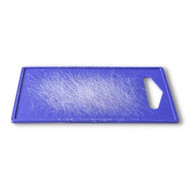Stop Sanding Your HDPE and Plastic Cutting Boards
17th Oct 2024
Here at Cuttingboard.com, we get a lot of phone calls from customers asking whether they can sand down their cutting boards to ultimately resurface the board to its original state. While it seems simple that sanding down your cutting boards should make them like-new, there are a few things you should know first.
Most of the boards on our site are wood cutting boards, which are normally okay to sand down to get rid of those pesky knife marks. We highly recommend cleaning the board thoroughly afterwards, and most importantly, you must oil your board with food-safe cutting board oil to preserve the wood as best as possible and prevent food oils and juices from penetrating the wood.
So what about plastic or HDPE (High-Density Polyethylene) cutting boards? Our answer is pretty simple: you should never sand down a plastic or poly cutting board to resurface it.
The Dangers of Re-Texturing HDPE (Plastic) Cutting Boards
When you purchase a brand new HDPE cutting board, you can feel that one side of the board is made with a semi-rough texture which is to prevent your food from moving while cutting it. When you sand down your HDPE cutting boards, you’re likely trying to get rid of knife marks and maybe even discoloration. However, you are also getting rid of that necessary semi-rough texture that keeps your food from slipping out from underneath your knife while cutting the food.

Unfortunately, your food sliding across the board is the least of your worries when you sand down your plastic or poly cutting boards. Losing the original texture of your plastic cutting board can also cause your knives to start slipping and potentially lead to cutting your fingers or hands.
Although the main goal of sanding down your plastic or poly cutting boards is to smooth down the surface and getting rid of your knife marks, the sanding process will ultimately lead to much smaller cuts on your cutting board that food particles can get trapped in. While most people use this material of boards to cut raw meats, you can see where that can be problematic. Even the best dishwashers will not always clean out those tiny cuts made by a sander, which will ultimately contaminate the food you cut on the board after sanding it.
While your wallet may not love replacing your plastic cutting boards, your stomach and health will definitely thank you in the long run. The good news is that we offer both standard sized plastic cutting boards and quick shipping to get your boards replaced as soon as possible. We also have a team in our warehouse here in Atlanta, Georgia that cuts custom HDPE and plastic cutting boards if you have a specific need.

